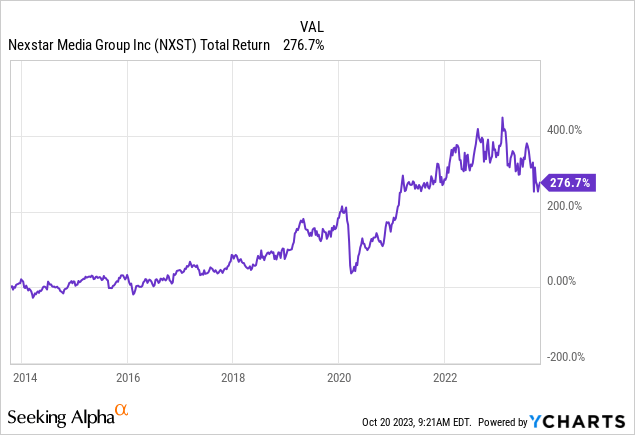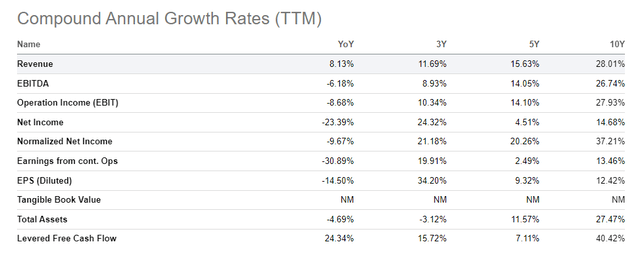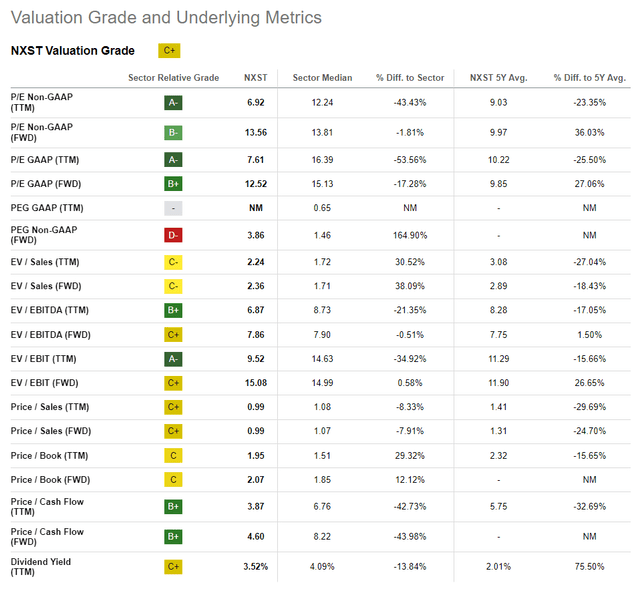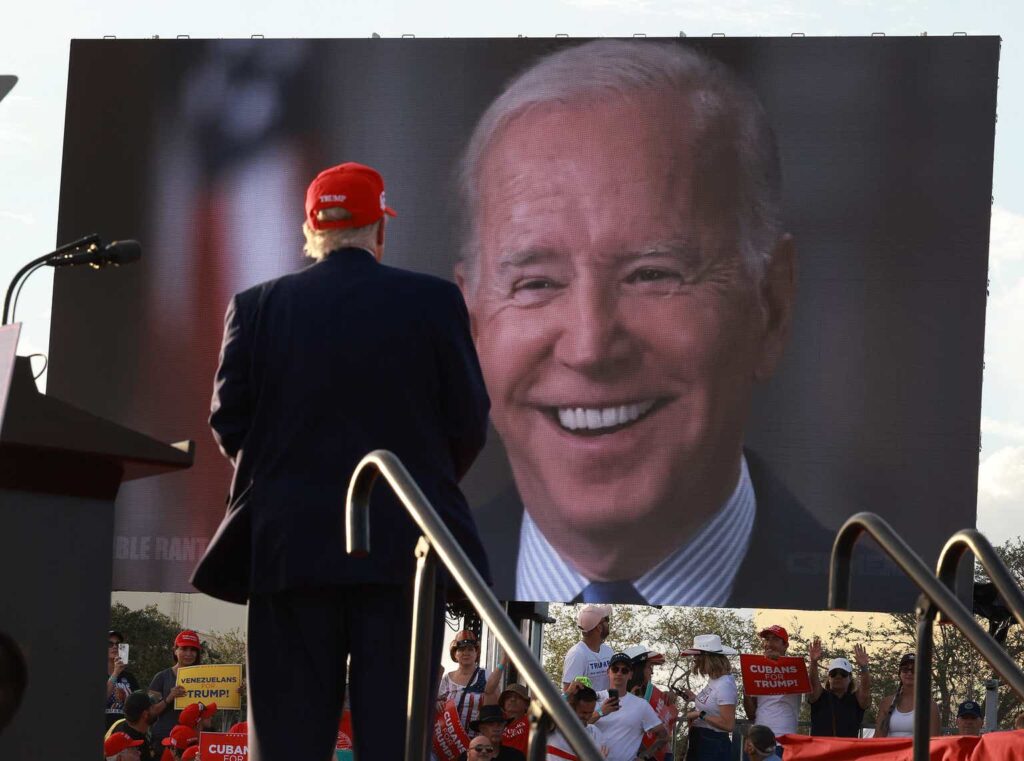In various regions, television advertising has been overshadowed by alternative forms of promotion. Nevertheless, in the realm of political ad spending, local TV stations remain a formidable force. Recent data indicates that they are poised to capture roughly half of the projected $10.2 billion in ad spending. Nexstar Media Group (NASDAQ:NXST), the largest local broadcast television group in the United States, stands to benefit significantly from the 2024 presidential election and is even rumored to be considering the acquisition of ABC from Disney (DIS). The company’s impressive historical growth rates and its modest valuation make it a compelling buy for value-oriented investors.
Company Overview
Nexstar was founded in 1996 when Perry A. Sook bought one TV station in Scranton, Pennsylvania (a town known for its excellent regional managers). Over the next 27 years through heavy M&A it has become the biggest local broadcaster of the US, reaching over 212 million people. In recent years it has expanded into other media ventures such as launching the national news network NewsNation and acquiring 75% of The CW. Perry A. Sook is still the chairman and CEO of this now sprawling media empire.
For investors in Nexstar, the last 10 years have been good, but not great, with a total return of 276,7%. This has been the period that Netflix (NFLX) and other streaming services were booming, but that doesn’t mean that the next few years might see the same results.

Recently I started rereading ‘The Snowball: Warren Buffett and the Business of Life’ by Alice Schroeder. In it there are some chapters dedicated to Buffett getting into the newspaper industry. This was in a time where newspapers were struggling due to the competition from TV and radio. The thing that attracted Buffett to this industry was that despite this competition, newspapers had predictable cash flows and, in their respective regions, almost monopoly-like characteristics. That all at modest multiples. Similar traits can be attributed to regional broadcasters. Technical advances have put them half a century later in a comparable position. The predictable cash flows and depressed valuation might also be a reason why Michael Bury bought Nexstar in Q2 of this year for his portfolio.
Financials
From my perspective the total return performance shown above does not do justice to the remarkable increase in the financial performance over the period. Revenues have grown from around $500 million in 2013 to over $5,250 million TTM. An increase of over 1000%. Better even is the net profit jump in that period. In 2013 Nexstar was $1.8 million in the red. TTM that has improved to $ 699.1 million in the black. The balance sheet has also expanded and is now significantly better. From minus $13.2 million in equity in 2013, it now has $2,543 million in common equity. However the amount of net debt is with $6,837 million, so still on the high side.
I already discussed cash flows a bit, but this is the area in which I think the company shows its true strength. TTM operating cash flow stands at $1,273 million and capex is just $171.3 million. This equates to over $1,100 million in free cash flow. Similar to many companies owned/managed by John Malone, cash flows here are YoY much higher than net profit and given the nature of the business they are fairly steady. This FCF gives ample opportunity to reduce debt, grow the company organically or via M&A, which it has done extensively in the past, or to return capital. At the moment the focus seems to be on returning capital to shareholders with TTM over $800 million in share repurchases and over $167 million in dividends. Given the current valuation I am more than happy with buybacks. Although with the rising interest rates, debt levels are kept in check. Looking beyond the use of FCF, one can’t be discontent with the capital deployment of Nexstar’s management. Given that the founder, Perry A. Sook is still onboard, has plenty of skin in the game and built the company from one single station to what it is today, trust can be placed in his capital deployment skills. Those who look at the total shares outstanding over the last 10 years, can notice that they are used to finance takeovers, but are bought back when it is interesting to do so. This is something that I find not to be the case with many companies.
What should be mentioned is that net income and operating cash flow has been higher than it has been over the last twelve months. This shouldn’t be a big issue as it is expected. While a large portion of the business is stable, there is an element of cyclicality. Large events such as the mentioned presidential elections or major sports events simply bring in more advertising revenue. Since many don’t happen every year, this means some up and down swings.
The scorecard for growth over the last decade is simply superb:

Seeking Alpha
Source: Seeking Alpha
Normalized net income growth of over 37% over a 10 year period and levered free cash flow over 40%. This is something you don’t see that often. Especially in a sector which is supposed to be dying according to some.
Valuation
So far we have established that Nexstar is a fast-growing business in an industry in decline. It is rather safe to say that massive multiples such as with SaaS companies can’t be expected. But the metrics are impressive. Remember, $1,100 million in FCF on an equity base of $2,543 million is a cash return on equity of over 40% per year. So for those who haven’t checked up the market cap of the company, it is currently around $ 5 billion. Meaning the company is trading at less than 5 times FCF. So how are other metrics lining up?:

Seeking Alpha
Source: Seeking Alpha
In this overview the sector that’s referred to with ‘sector median’, is the communication service sector. Within this sector I would say that TEGNA (TGNA), Sinclair (SBGI) and Gray Television (GTN) are most comparable. When looking at the 5-year average of Nexstar itself, it is clear that for many metrics the company is cheaper today. Given the expected surge in political advertising revenue and the diversification gained over the last few years, this seems unjustified. While it is very unlikely that Nexstar will ever be priced at 15 times FCF, the current valuation simply is very cheap. A potential valuation of 8 times FCF seems rather reasonable.
Tailwinds
As mentioned a few times before, the next presidential election cycle will most likely be a big driver of additional revenue from now until the 5th of November 2024. If indeed half of the $10.2 billion mentioned in the intro goes to local broadcasters, Nexstar as the largest of them can expect a sizable sum of it. Other major events such as for example the 2024 Paris Games can also make people tune in to watch sports or check the news in larger numbers.
A second point worth mentioning is that new transmission agreements such as the one recently made with DirecTV can add extra income. A separate deal made last month between Charter (CHTR) and Disney seems to point out that distributors such as Nexstar and Charter are starting to have better negotiation positions in the type of deals. While most people have been talking about cord-cutting over the last few years, I would not be surprised if this trend at some point actually somewhat reverses. Yes, many people canceled their TV subscriptions, but I feel this is starting to change. While Netflix was a pioneer, more and more competitors have popped up. Making availability more fragmented. Together with the introduction of ads and price hikes, this will make an old school bundle become increasingly more attractive. If it starts to cost more to actually have several different streaming services to get the almost same content as with a cheaper bundle, then people will subscribe to the cheaper bundle again.
Finally, the balance sheet and strong cash flows give further space to more M&A or do more share buybacks. Over the last three years net debt has been brought down by over $1.5 billion, so this gives an opportunity to expand beyond local broadcasting. The company has already started to do so with NewsNation. Also the majority ownership of The CW adds a broader content library to Nexstar. A few large media companies such as Disney and Warner Bros. Discovery are under pressure to reduce debt or shed assets. The potential deal for ABC could be a big boost for Nexstar. It is worth mentioning that Nexstar got the majority of shares in The CW without paying cash or shares, but simply assumed some debt for it. If M&A is not in the cards, then doing buybacks at a valuation below 5 times FCF is a great option.
Risks
Even though I am bullish on Nexstar, there are also realistic risks that need to be taken into consideration. As said, the company operates in a declining business, so this could decline even further and perhaps faster than anticipated. For now the cash flow gives ample opportunity to reduce the outstanding debt, which with rising rates could become more of a burden in the future. So the debt ratios need to be closely monitored. A second major risk is that growth beyond local broadcasting is more uncertain. Given the regulations in the industry, not much more expansion in local broadcasting can be expected. This leaves areas such as content creation or other media channels as sources of new revenues. The success here is yet to be determined and the profitability might be lower. Overall it is clear that there are definitely scenarios in which the future is less bright, but that’s also why the stock is priced this low.
Conclusion
From a value-based perspective, Nexstar is a strong buy. As the largest local broadcast television group in the US, it dominates political ad spending, and its impressive financial performance over the last decade has seen high growth. The company’s robust cash flows, low valuation, and prudent capital allocation provide an enticing opportunity for value investors. With diversification, potential windfalls from major events such as the upcoming presidential election, and favorable valuation, Nexstar offers a compelling investment proposition, despite certain industry-related risks.
Editor’s Note: This article was submitted as part of Seeking Alpha’s Best Value Idea investment competition, which runs through October 25. With cash prizes, this competition — open to all contributors — is one you don’t want to miss. If you are interested in becoming a contributor and taking part in the competition, click here to find out more and submit your article today!
Read the full article here



